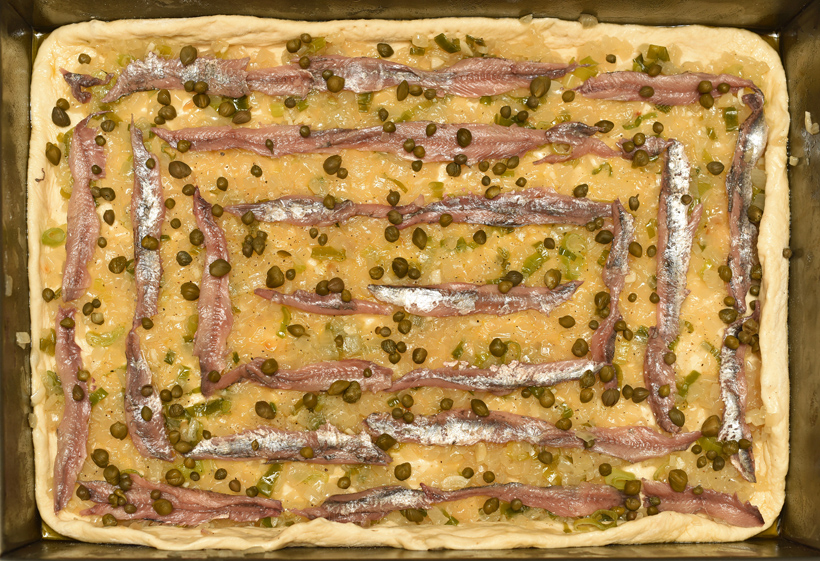The island of Vis, the farthest inhabited off the Dalmatian coast, has long been known for its fishing and its fishermen. Some go so far as to claim that the inventions of these fishermen changed the world. The first fish cannery on the Mediterranean was set right in Komiža, the island’s second largest settlement. In the early 20th century, many Komižini fishermen emigrated to America. In Washington State, they were among the first to introduce modern fishing methods, and helped pioneer the North Pacific salmon fishing industry. Others moved to Monterrey’s Cannery Row. Island-born Martin Bogdanović started the first fish cannery in San Pedro, California — the French Sardine Company, which later became StarKist. According to this website, another local, Jakov Kuljiš, invented the carbide light used when fishing for oily fish, and was granted honorary US citizenship as a result.
It is therefore not surprising that the island’s culinary specialty involves canned fish. It’s a kind of pogača (a cousin of the Italian focaccia), brushed with olive oil, and sparsely filled with anchovies or sardines, as well as some vegetables that are allegedly the object of fierce local rivalry. On one hand, the town of Vis, the largest and oldest settlement on the island, turns up the Viška pogača with just onions. On the other, Komiža has the audacity to add tomatoes to its Komiška pogača.
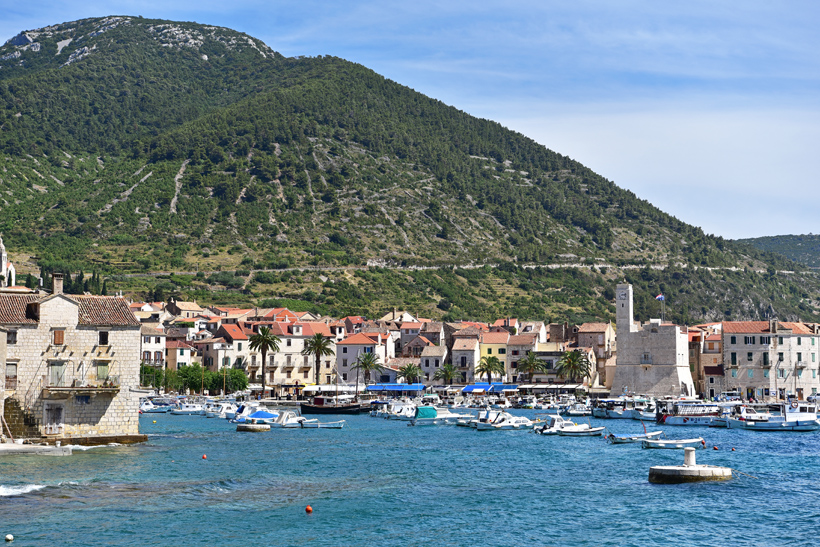
Komiža
Which one will you prefer, Vis’ minimalist creation, or Komiža’s ingredient debauchery? In pure Food Perestroika tradition, instead of siding with one town, I’ve chosen to alienate both. My Viška pogača adds some capers (which grow on the island) and garlic scapes, and my Komiška pogača uses roasted tomatoes, garlic scapes again, and parsley. For the dough, I’ve read several Italian focaccia recipes that basically call for ciabatta dough with olive oil, and made my own adaptation.
The result is thicker and airier than your typical pogača. Needless to say, I claim that my versions are best! I think I’ve achieved a very good result with the bread, though on its own, it’s still just bread. So don’t hesitate to pour more olive oil on top before eating it! I would also try to serve it with grilled fish (another one of the island’s specialties) and a vegetable, especially since Croatian side dishes tend to be very limited, and this would beat mashed potatoes any day.
In case you’re not convinced by my heretical additions, I will first provide a translation of the pogača recipes from Aldo Ivanišević’s amazing Dalmatinska Kuhinja, an 800-page, text-only, Croatian-only tome filled with recipes that the author collected over 25 years. You’ll find canonical Viška pogača and Komiška pogača, followed by an interesting third creation with olives, capers, and cheese, but no name. Aldo also suggests other variations. For the filling: cheese, chopped capers, chopped black or green olives, shrimp, basil, parsley, sage, Breckland thyme, or garlic. Mixed in the dough: olives, basil, rosemary, or Breckland thyme. He even proposes a panini — essentially a small pogača wherein the dough is simply folded over the filling to form a pocket.

Komiška Pogača at the Jastožera Tavern, Komiža
Base recipe [Viška Pogača] (Aldo Ivanišević)
Yields 1 pogača
1 kg of bread dough
10 salted sardines or anchovies
2-3 onions
0.5 dl of olive oil
pepper
- Prepare a bread dough, to which you can add a bit of olive oil and sugar (then you would use a little less yeast than for regular bread).
- Separate a bit more than a third of the dough from the rest, so you get two unequal pieces of dough. Roll both pieces to a thickness of 5-6 mm.
- Sauté the finely chopped onions in oil over medium heat until lightly colored, and reserve.
- Grease a baking pan, transfer the larger section of dough, and prick with a fork. Spread the cleaned sardine or anchovy fillets on top, then arrange the onions, and sprinkle with oil and pepper.
- Place the second, smaller piece of dough on top. Fold the edges of the bottom dough over the top, and use your fingers to seal. Cover with a cloth, and let rise for 30 minutes.
- Prick the top with a fork, and brush with oil. Bake in a 180 C / 350 F oven for 30-45 minutes.
Second recipe [Komiška Pogača] (Aldo Ivanišević)
Yields 1 pogača
- Place the larger section of dough into a baking pan, and prick with a fork. Bake in a 160 C / 325 F oven for 10 minutes.
- Take the pan out of the oven, and cover the dough with tomato sauce (or, if you don’t have any, strained tomatoes), keeping 2 cm clear around the edges. Season with oregano and pepper.
- Chop the fillets of salted sardines or anchovies into small pieces, and place them on the dough. Cover with the other piece of dough, and seal the edges.
- Prick with a fork, and bake in a 160 C / 320 F oven for 30-40 minutes. During the second half of the baking, you can slightly reduce the temperature.
Third recipe [Unnamed Pogača] (Aldo Ivanišević)
Yields 1 pogača
- After placing the dough into a baking pan, spread a sauce made of crushed black olives and capers (or without the capers), oil (from the salted fish jar or can, if available), and lemon juice.
- Arrange the chopped fillets of sardine or anchovy, sprinkle with some semi-hard cheese, and drizzle with olive oil. Cover with the other piece of dough, then fold the edges of the bottom dough over the top.
- Sprinkle with some grated cheese, and bake.
And now, the Food Perestroika versions!

Pogača pre-dough
Yields 2 pogačas
0.5 g active dry yeast
108 g water, lukewarm
180 g bread flour
- In a bowl, stir the yeast into the water. Add the flour, and mix until just smooth. The mixture should be stiff and dense.
- Cover with plastic wrap, and leave at room temperature for at least 12 hours.
- Note that this makes enough pre-dough for 2 pogačas, but the recipes below each yield one.
Pogača dough
Yields 1 pogača, about 760 g dough
2 g active dry yeast
5 g sugar
240 g water, lukewarm
375 g bread flour, sifted
10 g salt
15 g olive oil
1/2 (140 g) pogača pre-dough
- In a small container, combine the yeast, sugar, and about 1/5 of the water. Let rest for 5 minutes.
- In the bowl of an electric mixer fit with the paddle attachment, add the yeast mixture, the remaining water, and half of the flour, and mix on low speed until homogeneous. Scrape down the sides of the bowl with a spatula, add the remaining flour and the salt, then mix for 3 minutes, still on low speed.
- With the mixer still on, add the olive oil, then the pre-dough in chunks and mix until homogeneous.
- Switch to the dough hook, and knead on low speed for 4 minutes. The dough should be loose and sticky. Cover and let rise for 1 to 1 1/2 hours, until doubled in volume.
- Fold the dough (explanations here), then cover again and let rise another hour.
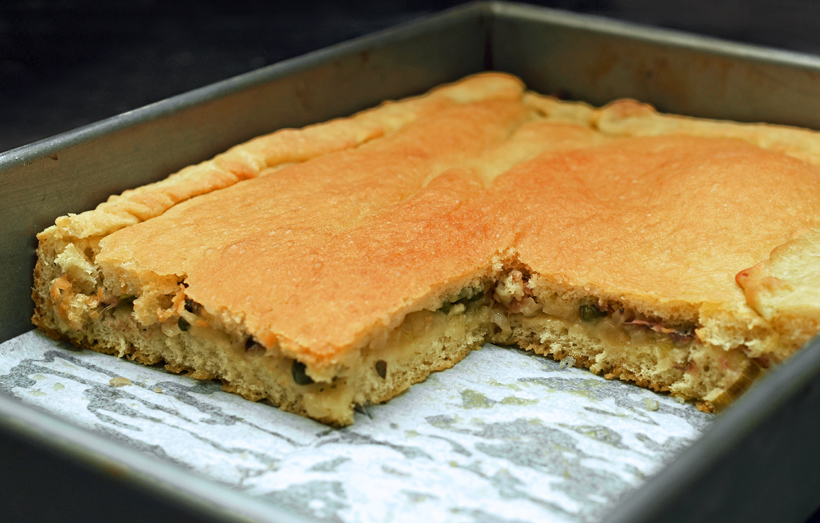
Roasted tomatoes
Yields 1 pogača (about 280 g tomatoes)
600 g tomatoes
35 g olive oil
salt
black pepper, ground
- Core the tomatoes, and cut them in half. Transfer to an oven dish, cut side up. Drizzle with the olive oil, and season with salt and pepper. Bake in a 175 C / 350 F oven for 1 hour.
- Prick the cut side of each tomato with a knife a couple times, to help release the moisture. Flip the tomatoes upside down, then bake for 1 more hour at 150 C / 300 F.
- Peel the tomatoes, and transfer to a bowl with the oil from the oven dish. Let cool and reserve.
Onion mixture
Yields 1 pogača
350 g peeled sweet onion, small dice
30 g olive oil
40 g garlic scapes, brunoise
salt
black pepper, ground
- In a pan over medium heat, sauté the onion in the olive oil until soft.
- Add the garlic scapes, season with salt and pepper, and cook until the onion starts to color, stirring regularly.
- Transfer to a bowl, let cool, and reserve.
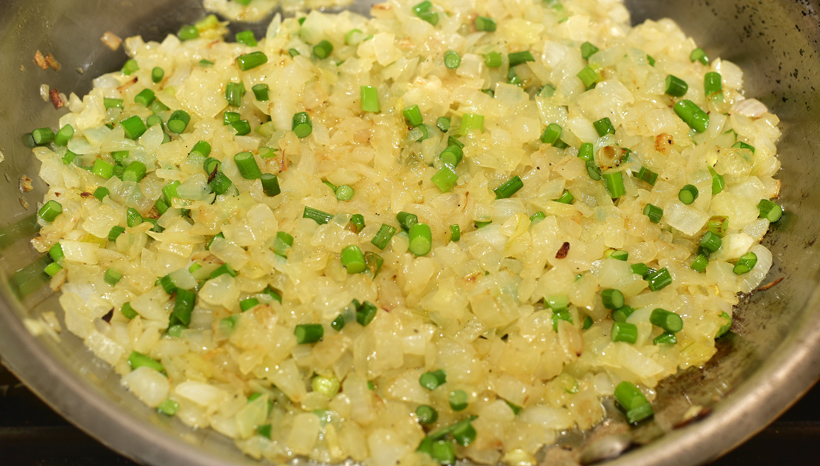
Komiža Pogača (Komiška Pogača)
Yields 1 pogača (9 slices)
120 g whole salted anchovies
pogača dough
60 g olive oil
roasted tomatoes
onion mixture
8 g parsley, coarsely chopped
- Rinse the anchovies under cold water, then soak in a bowl of cold water for 30 minutes, changing the water about halfway through.
- Drain and pat dry the anchovies, and fillet (that is, remove the central bone). You should end up with about 60 g of anchovy fillets.
- Separate the dough into two unequal balls, one slightly over 1/3 of the total (about 300 g), and the other slightly less than 2/3 (about 460 g).
- Grease a 25 cm x 37.5 cm metal baking pan with 2/3 of the the olive oil.
- Roll the larger piece of dough to a 29 cm x 41.5 cm rectangle (the size of the pan, plus 2 cm on each side), and transfer to the pan. Prick with a fork. Spread the roasted tomatoes over the dough, then add the anchovies, the onion mixture, and the parsley in that order.
- Roll the smaller piece of dough to a 25 to 37.5 cm rectangle (the size of the pan). Cover the pogača, then fold the edges of the dough from the bottom layer over the top layer and press with the back of a fork to seal. Cover and let rise for about 1 hour (or 45 minutes in a 38 C / 100 F environment).
- Place a dish of water on the bottom rack of an oven heated to 200 C / 400 F.
- Brush the top of the pogača with the remaining olive oil, then prick with a fork. Bake on the middle rack for about 30 minutes, until golden brown.
- Take the pogača out of the oven, and let cool for about 15 minutes. Cut into 9 slices (3 x 3) and serve.
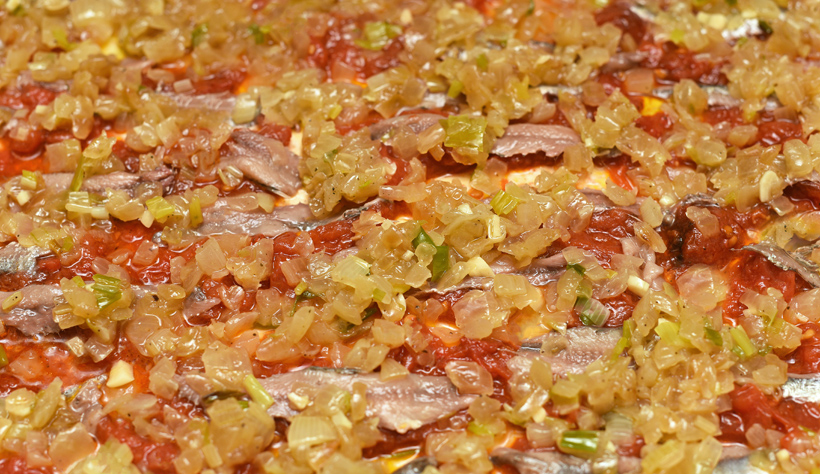
Vis Pogača (Viška Pogača)
Yields 1 pogača (9 slices)
120 g salted anchovies
30 g drained capers
pogača dough
60 g olive oil
onion mixture
- Rinse the anchovies under cold water, then soak in a bowl of cold water for 30 minutes, changing the water about halfway through.
- Drain and pat dry the anchovies, and fillet (that is, remove the central bone). You should end up with about 60 g of anchovy fillets.
- Soak the capers in cold water for 5 minutes, then drain and pat dry.
- Separate the dough into two unequal balls, one slightly over 1/3 of the total (about 300 g), and the other slightly less than 2/3 (about 460 g).
- Grease a 25 cm x 37.5 cm metal baking pan with 2/3 of the the olive oil.
- Roll the larger piece of dough to a 29 cm x 41.5 cm rectangle (the size of the pan, plus 2 cm on each side), and transfer to the pan. Prick with a fork. Spread the onion mixture over the dough, then add the anchovies and the capers in that order.
- Roll the smaller piece of dough to a 25 to 37.5 cm rectangle (the size of the pan). Cover the pogača, then fold the edges of the dough from the bottom layer over the top layer and press with the back of a fork to seal. Cover and let rise for about 1 hour (or 45 minutes in a 38 C / 100 F environment)
- Place a dish of water on the bottom rack of an oven heated to 200 C / 400 F.
- Brush the top of the pogača with the remaining olive oil, then prick with a fork. Bake on the middle rack for about 30 minutes, until golden brown.
- Take the pogača out of the oven, and let cool for about 15 minutes. Cut into 9 slices (3 x 3) and serve.
